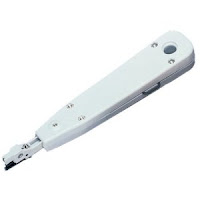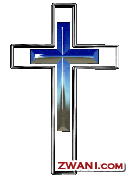 A punch down tool, also called a punchdown tool or a Krone tool (after wiring systems manufacturer ADC Krone), is a small screw-driver sized tool used for connecting wiring to a punch down block[1]. The tool consists of a handle with a spring mechanism inside and at the tip a small square piece of metal with a square hole in it. To use the punch down tool, a wire is inserted in between the two metal blades on a punch down block and the punch down tool is pressed down on top of the wire and the two blades on the punch down block. This requires a bit of pressure until with an audible snap the wire is stripped and contact made as it is pushed down between the two punch down block blades.
A punch down tool, also called a punchdown tool or a Krone tool (after wiring systems manufacturer ADC Krone), is a small screw-driver sized tool used for connecting wiring to a punch down block[1]. The tool consists of a handle with a spring mechanism inside and at the tip a small square piece of metal with a square hole in it. To use the punch down tool, a wire is inserted in between the two metal blades on a punch down block and the punch down tool is pressed down on top of the wire and the two blades on the punch down block. This requires a bit of pressure until with an audible snap the wire is stripped and contact made as it is pushed down between the two punch down block blades.
Wednesday, December 19, 2007
PUNCH DOWN TOOL
Posted by JeB at 5:44 PM 0 comments
PATCH PANEL



A patch panel is mounted hardware unit containing an assembly of port locations in a communications or other electronic electrical system.In a network(LAN) and to the outside for connection to the Internet or other wide area network(WAN).A patch panel uses a sort of jumper cable called a patch cord to create each interconnection.Cat 5e patch panel is available in 12 to 72 ports.All panels are 19 inch rack mount and support both 568A and 568B installations. Compatible with both 110 Block、LSA Block and block.
A patch panel or patch bay is a panel, typically rackmounted, that houses cable connections. One typically shorter patch cable will plug into the front side, while the back will hold the connection of a much longer and more permanent cable. The assembly of hardware is arranged so that a number of circuits, usually of the same or similar type, appear on jacks for monitoring, interconnecting, and testing circuits in a convenient, flexible manner.Patch panels offer the convenience of allowing technicians to quickly change the path of select signals, without the expense of dedicated switching equipment. This was first used by early telephone exchanges, where the telephone switchboard (a massive array of patch panels) and a large room full of telephone operators running it was ubiquitous.
Uses and connectors
They are not only used in telephony and data, but in other audio and video applications. Patch bays are used at installations where it is necessary to connect and reconnect various hardware devices, for example at technical control facilities, patch and test facilities, at telephone exchanges, broadcast studios, and recording studios.
Patch panels can have any number of different types of electrical connectors, often having a different type on the front than the back. If it has a compound connector on the back and individual ones on the front, it is also a breakout box. One example is a DB25 connector used for 8-channel balanced line audio, which is split into eight XLR or TRS connectors on the front.
Patch bays facilitate flexibility in the use, routing or restoration of a variety of circuit types, such as dc, VF, group, coaxial, equal-level, and digital data circuits. Patch panels accepting industry standard keystone modules are also available, allowing a variety of connectors to be used on a single panel.
In telephony and data, the 66 block and 110 block are punch blocks often used as patch panels. These have insulation-displacement connectors for quick wiring of wires which have no attached connectors. Old switchboards used tip-ring (TRS) connectors on the front, still the most common type used now for audio.
Posted by JeB at 5:26 PM 0 comments




